As bushfires raged from all directions towards the historic village of Wollombi last summer, a herd of abandoned Standardbreds emerged from the hills. Seeking shelter, food and water, these emaciated survivors found care, compassion and safety in the hands of a small group of locals.
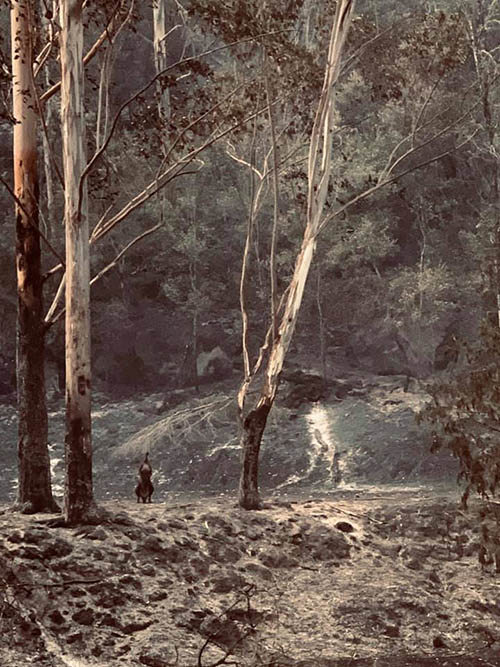
“It was almost surreal –
like an ancient scene from
another time and place.”
A year on, while memories of the catastrophic fires that tore across parts of Australia during the Black Summer will forever be etched in the hearts and minds of those who experienced their destruction first-hand, the journey that these horses – now collectively known as the Orphan Horses of Paynes Crossing – have undertaken, is a story of hope, recovery and new beginnings in the wake of devastation.
In December 2019, the secluded, tourist-friendly historic village of Wollombi, NSW, was surrounded by out-of-control fires. With the vast Gosper’s Mountain fire raging to the south, the Little L fire to the west, the Crumps Complex fire to the east, and Owendale blaze to the north, there was doubt whether the village could be saved. The community rallied, and help arrived – at one stage there were more than 20 tankers and 37 crews in the village – with locals fighting fires alongside firefighters from interstate, New Zealand, and from as far away as America.
Yet there were areas that the NSW Rural Fire Service could not protect due to issues such as access and lack of radio service, and these were left entirely to the locals to defend. One such area was Paynes Crossing, part of the Wollombi Valley. As residents including Fiona Migan battled from sunrise to sunset for weeks on end, their focus on saving lives and property was as relentless as the scorching conditions they faced. There was little room in their minds to think about anything else.
For Fiona, a surprise encounter with a band of horses in the midst of a torrid Black Summer week, would set in motion a courageous effort to provide critical care for animals in need at a time when help and resources were scarce, emotions were high, and people’s capacity to give support – financially, practically and emotionally – was drained.
“We were in an area called Stockyard Creek, helping to defend the valley. It’s at least 15km long, and it was hit pretty hard by the fires. At the end of one long day I was sitting out in the paddock of a property we were defending lower down the valley, totally exhausted from fighting fires for about a week, when suddenly the horses appeared. They came down the valley so calmly; the sun was setting as they appeared through the smoke haze. The way they moved together as a herd, and the way they looked with their dreadlocked manes, it was almost surreal – like an ancient scene from another time and place.
“It totally caught my heart. I was obviously exhausted and quite emotional, and there I was completely captured by the sight of them. I went and stood near them; they weren’t really interested in me or having anything to do with me, but I just watched them interact as a herd. It was a really, really beautiful moment,” Fiona recalls.
While Fiona had previously heard stories about some old Standardbred horses who roamed the hills above Wollombi, this was the first time she had seen them in the flesh. “I knew they existed, but there was never much information about them. There are a few different versions of their past; I’d heard they belonged to a man and his girlfriend, and he was a criminal. When he went to jail, they were left to fend for themselves, and lived in this huge area of bushland without any human help or interaction for about 15 years.”

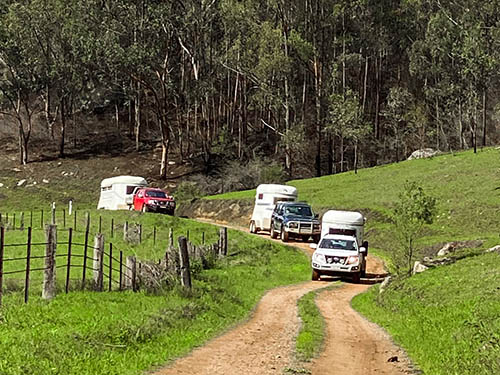

“I was completely captured
by the sight of them.”
The geldings were in shocking condition. Even prior to the bushfires, they had endured tough times; the area had been ravaged by drought for several years and the elderly horses had clearly not accessed quality grazing for some time. “I was shocked to see how thin they were, but also amazed that they had survived, living out of the bush through the drought, and that they were now surviving the fires,” Fiona recalls, adding: “I was determined to do whatever I could to help them.”
Following Fiona’s first sighting, there was a period of around two weeks during which she tried to work out a plan for the herd. “There were a few of us here that were trying to work out what to do. My hope was that they could remain living in that stretch of land that they had obviously lived in for a long time. They hadn’t been lower down the gully before, but the fence that had held them up there had burned,” Fiona explains. “There’s a lot of pasture and arable land there, so I was hoping that we could somehow get the community in that valley on board with the horses staying.”
It was not to be, and Fiona was disheartened to discover that many believed the right outcome for a group of thin, old, unrideable horses was euthanasia. “The word ‘abattoir’ was mentioned a few times,” says Fiona. “I couldn’t let that happen knowing what they’d already been through. Those horses had survived so much, that couldn’t be their ending.”
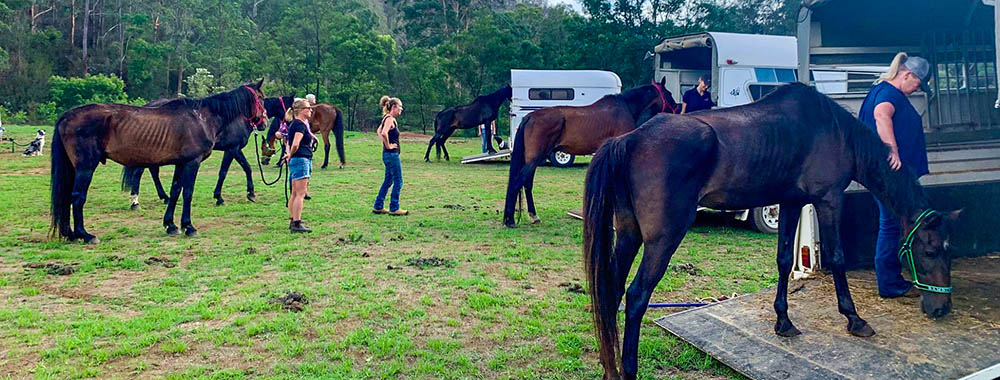

“It was a really, really
beautiful moment.”
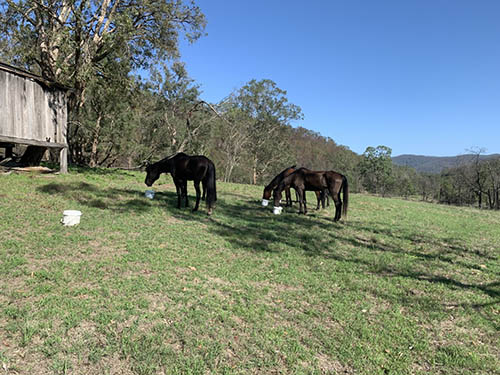
Fiona was not the only one who felt that way. Another lady, Ash, who owned property in the area, was keen to arrange homes for the horses, and various people were putting up their hands to take on individuals. While this was a far better option than euthanasia, Fiona did not want to settle for a plan that involved separate rehomings.
“I just didn’t feel like it was right for a herd that had lived like that for so long to be split up. So I decided to raise money for them and just see if I could find some land for them to live on,” Fiona explains. “A lot of people thought I was crazy and that it was never going to happen. But once we got the word out it just took off!”
To the delight of Fiona and all who were working to secure a soft landing for the herd, a family offered their property as a permanent home. “It was incredible. They’re weekenders, and were happy to have the horses there. The property is about 100 acres, and it’s got a really old homestead and no one that really lives there permanently. Next, Peat’s Ridge Saddlery came on board, donating halters and grooming gear. And then more people just started coming forward out of nowhere, just saying they wanted to help.”
It would be around a month before the herd were able to travel to their new home. Some loads of hay were purchased and the herd remained in the Stockyard region where they had been found. “I don’t remember the exact timing – it was such a stressful period – but we had hay and some basic pellets and started hand-feeding them, because they needed it,” Fiona explains, adding that some of the herd were fine with human contact – whereas others weren’t and still aren’t – despite being handled when required for necessary care.
“Feeding definitely helped, in terms of getting them used to humans again after so long on their own,” Fiona recalls. “It was actually fairly soon after we started feeding them that most were like, ‘Okay, you can touch us, people!’ Probably the coolest moment when we initially started helping them was when we had to get their teeth done. We had enough money, and so our vet came and we had to drive him up there – it’s about a 45-minute drive to find the horses. He said, ‘Well, how are we going to catch them?’ But we didn’t really know! It was me and my friend Jed, and we just took some baling twine and I walked up to one of them; I don’t know why, but it felt like they just knew what we were doing, that we were helping. So they were all sedated and had their teeth done.”
When the day finally came to move the herd of seven to their new 100-acre paradise, a wonderful group of volunteers gathered to help. As Fiona explains, they had no idea how well the move would go. “I thought there was no way those horses would load on to floats! I assumed they’d all been on trucks before, but not on floats. We went out there early in the morning because we thought it was going to take all day to get those guys on. And they all walked straight on!” Fiona laughs.
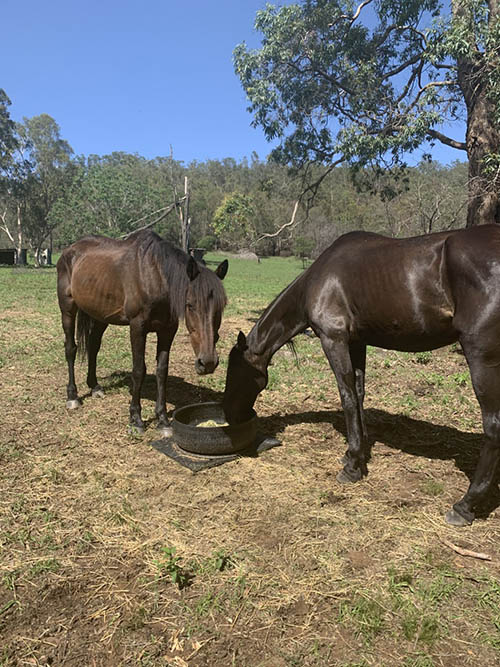
“Once we got the word
out it just took off!”
Witnessing the herd’s arrival at their new home was an emotional moment for those who had helped them reach that point. In the lead up to the move, the property’s dams were dry due to drought and fires, and arrangements were being made to buy a tank, order water, and use a bathtub to provide water for the horses. Simply providing water – the most basic of equine needs – would be a significant task. Yet around a week before the move, a rain event filled all the dams and the property was transformed into an abundant paradise; a far cry from the conditions that these tough horses had endured.
“When they arrived, they all just started grazing and then off they went, happy as can be, so calmly,” Fiona recalls. “It’s the most amazing place, there are about five dams and this huge barn where we can keep all of their feed and fit around 100 bales of hay – it’s simply perfect.”
While the herd settled quickly into their new home, being elderly – a trace of their brands revealed they were all aged over 20 – and very underweight, the geldings would clearly need a lot of care and feed to help restore their health. It was a commitment their guardians – the 15 or so volunteers who work on a roster system to care for them – were willing to undertake.
“Originally we got Carol Layton to do a nutrition plan for them. And I think if we hadn’t, we probably would have wasted a lot of money on food that perhaps wasn’t going to do the job,” Fiona explains. “Initially we had them on two small feeds a day, ideally they would have been on four smaller feeds, however it wasn’t feasible; nevertheless, the change they underwent in just a few months was incredible. They are now fed once a day and have access to amazing grass and minerals.
“Their little faces still, when you feed them, are like ‘no way, this is for me?’ Four of the six look great now. Two of them don’t look great, I’m not sure they ever will again. They’re bright in the eye but they’re still a bit ribby!”
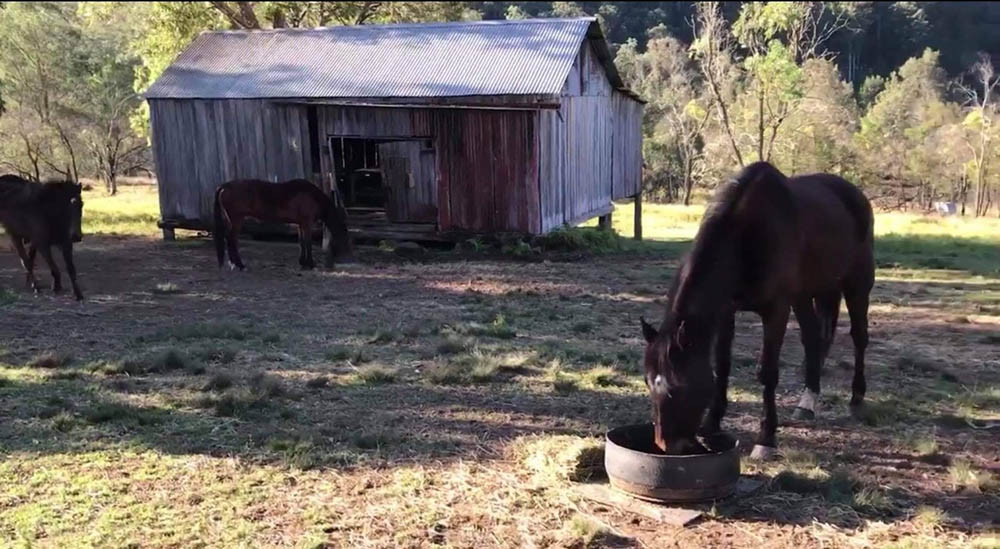

“It’s very horse-centric,
it’s not about the humans.”
All six of the remaining herd – Juniper, Pops, Baz, Braveheart, Zoro and Fitch – will live out their days in their new home. Sadly, one of the herd, Uncle, was laid to rest during 2020 due to ongoing issues with choke. “Uncle was my favourite,” Fiona states emphatically. “Of all of them he was the easiest to handle and catch, he was the biggest sweetheart, and the bottom of the pecking order. And he had this big dreadlocked mane; I’ve kept one of his dreadlocks, actually.
“The owners of the property have been, and continue to be, so generous. They could be agisting cattle on the place; instead they gave the herd a home. They even feed them when they come up to stay,” says Fiona. “And the volunteer team are just next level. Everyone steps up and takes a different role, it wouldn’t work otherwise. I was really clear from when I started this that they’re not my horses, it’s not my project. I might have been the first one to start doing something, but it’s got to be a team, a collaboration. And that’s what it has become, which is amazing.
“There’s also been such positive engagement from the horse community in Wollombi particularly, which is really beautiful to see. It’s quite overwhelming how much everyone’s putting into it, and continues to put into the project,” Fiona continues. “Our goal, our aim with them is to keep them healthy and happy, and to be as hands-off as we can. We don’t handle them too regularly, we will catch them to get their feet done or to worm them, or if they need some Permoxin (insecticide rinse for ticks and other biting insects) or something like that. But they don’t need us. They don’t need human affection or attention – so if there’s something that they need, we make sure they have that – but if not, we leave them be. It’s very horse-centric, it’s not about the humans. It’s about doing the right thing by animals who, through no fault of their own, ended up in a horrible situation.”
Fiona is pragmatic about their future while pausing to reflect on what has been achieved. “They’re in their 20s, so they’re not going to be with us for forever. But they are definitely a symbol of hope after everything the community went through. To see them now when it is so lush and green again, it makes last summer feel like much more than a year ago. Last night I was out there to feed them, and it was absolutely bucketing down with rain. There I was in the rain feeding them and they were like a bunch of feisty colts – I thought I was going to get kicked! They were going off their faces – and my gosh – it was so beautiful. Everything with this project, from the moment that they first walked down the valley to now, it’s all fallen into place and been the most beautiful, humbling experience.”
A fundraiser has recently been launched to help with the herd’s feeding, dental, hoof care and veterinary costs. If you would like to contribute, visit the Facebook fundraiser here.

